

About our Plant
Fabryka Transformatorów w Żychlinie has over 90 years of experience in manufacturing transformers.
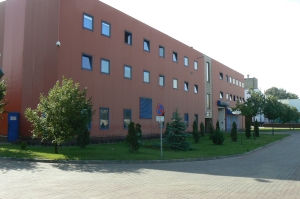 It was the first successful company within electrical machinery industry in Poland. The history of the Plant dates back to 1921 when it started operating on a large scale in Żychlin. There, under the name Polskie Zakłady Elektryczne Brown Boveri SA, housed in the buildings of the former sugar plant “Walentynów” equipped with its own power plant, it started producing transformers, three-phase motors, generators, and later also the first Polish tram motors.
It was the first successful company within electrical machinery industry in Poland. The history of the Plant dates back to 1921 when it started operating on a large scale in Żychlin. There, under the name Polskie Zakłady Elektryczne Brown Boveri SA, housed in the buildings of the former sugar plant “Walentynów” equipped with its own power plant, it started producing transformers, three-phase motors, generators, and later also the first Polish tram motors.
Production began in 1923 with the output of 14 pieces of electrical machinery. The following years led to an increase of the production: 1924 – 90 pieces, 1925 – 216 pieces. It was a period of very dynamic growth of the company. The whole production at that time was based on the license documentation of the Swiss corporation, i.e. Brown Boveri.
In the 1930s the plant started producing transformers and other electrical machinery according to the Polish designs and these proved to be very competitive comparing to products of other companies. In 1931, operation of the Plant became unprofitable due to the global economic crisis and therefore it had to be closed down for 2 years. In 1933 the plant was re-opened under the new name, i.e. Zakłady Elektromechaniczne Rohn-Zielinski SA licensed by Brown Boveri. The company was managed by CEO, Zygmunt Okoniewski M.Sc. Several years before the outbreak of the Second World War the Plant in Żychlin won a tender for supplying transformers for the Mościce – Starachowice segment of the first high-voltage line in Rożnów Warsaw. Transformers for the power plant in Rożnów come from that period. During the Second World War the plant operated as a part of Brown Boveri, a German company from Mannheim. After the war, the plant was nationalized and given the following name: Zakłady Maszyn Elektrycznych i Transformatorów M-1. Production started again on March 15, 1945. The Plant remained the leading manufacturer of electric motors and transformers in Poland.
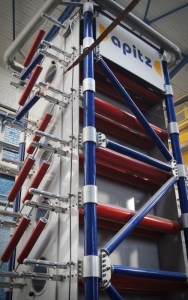 In 1967, its name changed once again to Zakłady Wytwórcze Maszyn Elektrycznych i Transformatorów EMIT. In the 1960s and 1970s, the Plant was expanded and its machine park was modernized.
In 1967, its name changed once again to Zakłady Wytwórcze Maszyn Elektrycznych i Transformatorów EMIT. In the 1960s and 1970s, the Plant was expanded and its machine park was modernized.
In 1991 EMIT was once again converted into a joint-stock company with the main shareholder being Elektrim SA from Warsaw. Investments made between 1996 and 1999 resulted in a dynamic increase in the production of transformers incorporating state-of-the-art materials and technology. The production range was extended with dry-type and cast resin transformers as well as with the new series of oil-immersed distribution transformers made according to the European standards. Within the above investment, a new production hall equipped with the most innovative machines was also built.
In November 2001 the Plant was divided. A new company was established under the following name: EV Żychlińskie Transformatory owned by Elektrim-Volt from Warsaw. In December 2005 the owner of the plant changed and since 2006 it has been operating under the current name, i.e. In November 2001 the Plant was divided. A new company was established under the following name: EV Żychlińskie Transformatory owned by Elektrim-Volt from Warsaw. In December 2005 the owner of the plant changed and since 2006 it has been operating under the current name, i.e. Fabryka Transformatorów w Żychlinie.
The production range of Fabryka Transformatorów w Żychlinie includes oil-immersed transformers, dry and resin transformers, as well as various reactors also designed in oil and dry types.
Oil-immersed transformers.
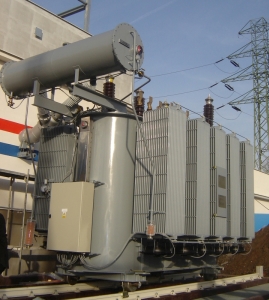 As it was already mentioned, Fabryka Transformatorów w Żychlinie has more than 90 years of experience in manufacture of transformers, including power generation and distribution transformers, with power rating up to 80000 kVA, furnace transformers and choking coils for various applications, earthing transformers and arc-suppression reactors. The transformer cores are made of low-loss, cold-rolled transformer plate covered with inorganic insulation. The step-lap cross-section of the core column is almost circular in shape, featuring optimum, computer-designed, number of steps for full filling of the cross-section and required flux density. Column and yoke plates (mitred strips on the ends) are carefully fagotted, ensuring good magnetic properties. The designed core construction enables reduction of no-load losses and the level of noise. The transformer windings are made of electrolytic copper. Bottom winding (low voltage) is made with thin copper foil or with a few parallel conductors of profiled cross-section in paper insulation. The upper voltage windings are made with round cross-section wire in varnished insulation or with profiled cross-section wires in paper insulation. The oil ducts located between the windings ensure required oil circulation and appropriate cooling. Construction and mounting of the windings guarantee very good dielectric resistance, high lightning resistance and excellent short-circuit strength. The upper voltage winding features taps for voltage control.
As it was already mentioned, Fabryka Transformatorów w Żychlinie has more than 90 years of experience in manufacture of transformers, including power generation and distribution transformers, with power rating up to 80000 kVA, furnace transformers and choking coils for various applications, earthing transformers and arc-suppression reactors. The transformer cores are made of low-loss, cold-rolled transformer plate covered with inorganic insulation. The step-lap cross-section of the core column is almost circular in shape, featuring optimum, computer-designed, number of steps for full filling of the cross-section and required flux density. Column and yoke plates (mitred strips on the ends) are carefully fagotted, ensuring good magnetic properties. The designed core construction enables reduction of no-load losses and the level of noise. The transformer windings are made of electrolytic copper. Bottom winding (low voltage) is made with thin copper foil or with a few parallel conductors of profiled cross-section in paper insulation. The upper voltage windings are made with round cross-section wire in varnished insulation or with profiled cross-section wires in paper insulation. The oil ducts located between the windings ensure required oil circulation and appropriate cooling. Construction and mounting of the windings guarantee very good dielectric resistance, high lightning resistance and excellent short-circuit strength. The upper voltage winding features taps for voltage control.
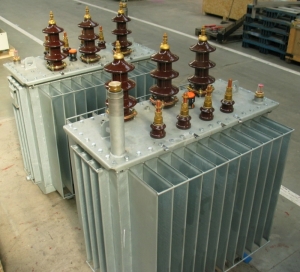 We use various tap changers, depending on required control type: on load or dead. The tap changer is built into the transformer tank, and features manual or motorized drive located on the tank, depending on the type and size of the transformer. The transformer tanks are made of steel sheets in a welded structure appropriately strengthened ensuring proper mechanical resistance. The heat is evacuated via the radiators or the wave on the tank’s sides.
We use various tap changers, depending on required control type: on load or dead. The tap changer is built into the transformer tank, and features manual or motorized drive located on the tank, depending on the type and size of the transformer. The transformer tanks are made of steel sheets in a welded structure appropriately strengthened ensuring proper mechanical resistance. The heat is evacuated via the radiators or the wave on the tank’s sides.
The volume of oil changes with the temperature which is not constant during transformer operation, thus causing the fall or rise of oil level in the conservator, or - in case of the tight (distribution) transformers – the increase or decrease of the pressure in the tank. The oil volume changes are possible owing to flexible walls of the tank. The high-rating furnace transformers feature an oil and water cooling system implemented by means of coolers and pumps.
The tank features an undercarriage, with wheels which can travel longitudinally or transversally. The transformers are connected by porcelain bushings, flat or connector (the latter are offered upon request, for example from Pfisterer or Euromold) located on the lid. The transformers are equipped according to Polish and international standards, and the equipment can be customized. The oil-immersed transformers manufactured by Fabryka Transformatorów w Żychlinie meet the requirements of the IEC 76.1 and PN-EN 60076-1 standards. Their parameters are comparable with transformers made by leading international companies.
Dry-type resin transformers.
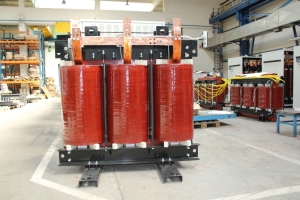 The resin transformers are required to ensure high level of reliability, long life and environment protection. The winding of these transformers is made in the resin technology, and the transformers feature the best insulation materials from renowned suppliers.
The resin transformers are required to ensure high level of reliability, long life and environment protection. The winding of these transformers is made in the resin technology, and the transformers feature the best insulation materials from renowned suppliers.
The available power range of the dry-type transformers is from 63 to 10000 kVA; supply voltage range: from 6300 to 36000 V. The 6300 kVA and 35/6 kV transformers were made upon a customer order. The transformers are designed and engineered with the latest calculation and graphic computer software. Computerized design means that a transformer is engineered quickly, and all operational parameters and values are calculated and known beforehand. It also enables optimization and choosing the best design version. The transformer cores (in three-column arrangement) are made of low loss, cold-rolled transformer plate covered with inorganic insulation. Their design is similar to the cores of oil-immersed transformers. Bottom windings (low voltage) are made with thin copper foil or with a few parallel conductors of profiled cross-section in varnish H-class insulation. The strips are insulated with a layer of special composite, bonding adjacent coils. Such solution provides high resistance to short-circuit forces, full tightness of the winding making the ingress of moisture and chemical fumes impossible, while ensuring high dielectric resistance. The high voltage winding are made with round or profiled cross-section wire in varnish H-class insulation. The winding layers are insulated with glass tape saturated with semi-hardened epoxy resins (rowing). Following the winding, it becomes a monolith, with high mechanical and electrical strength. The winding has adjustment taps, enabling voltage control.
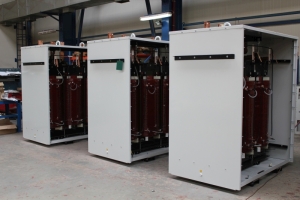 The coils, after winding and hardening, are fixed and wedged to the core columns, connected in required configurations, and finally mounted on the undercarriage or (upon request) in metal housings with required protection class.
The coils, after winding and hardening, are fixed and wedged to the core columns, connected in required configurations, and finally mounted on the undercarriage or (upon request) in metal housings with required protection class.
The resin transformers are environment friendly, and their insulation systems feature slow-burning and self-extinguishing materials. It is worth noting that the materials do not emit any toxic gases at high temperatures.
Resin transformers can be applied wherever other transformer cannot be used as a result of safety considerations and difficult operating conditions. One of the advantages of resin transformers is simple and easy installation and assembly. The resin transformers manufactured by Fabryka Transformatorów w Żychlinie meet the IEC, EN and DIN standards.

